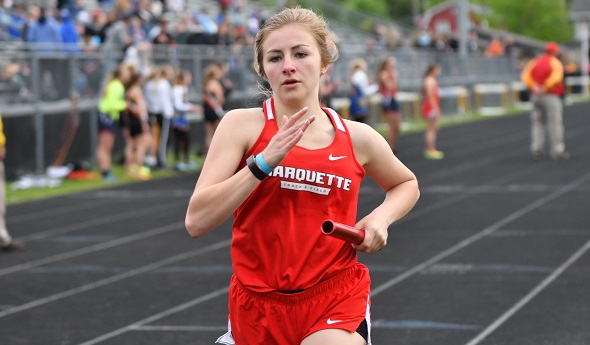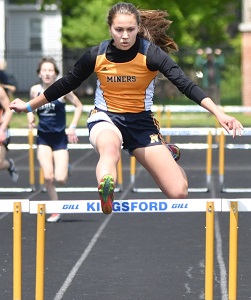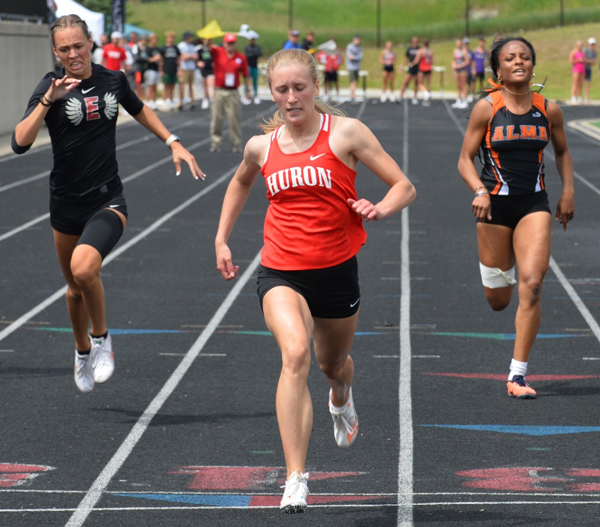
Marquette Clinches Win in Final Event
By
John Vrancic
Special for MHSAA.com
June 1, 2019
KINGSFORD – The race for the Upper Peninsula Division 1 girls track & field championship came down to the wire here Saturday, as Marquette edged reigning champion Negaunee 106-100.
Marquette secured its eighth title in nine years by winning the 1600-meter relay in four minutes, 14.58 seconds.
Negaunee, which held a three-point lead going into the day's final race, took sixth in the 1,600.
"What a day," said Marquette coach Natalie Messano. "It was a battle all day. Negaunee has a great team. It's real stressful as a coach, although I had faith in our girls. We had our eye on the trophy. But they made us work for it, that's for sure."
Negaunee gained the upper hand in the previous race with juniors Emily Paupore and Talon Prusi going 1-2 in the 3,200 run on this sunny and warm day at Flivver Field.
Paupore retained her 3,200 title in 11:57.64, with Prusi at 12:32.67 and Marquette sophomore Josie Danielkiewicz third (12:36.32).
"It was close all the way," said Negaunee coach Vickie Paupore. "To say I'm proud of our team is an understatement. Talon really stepped up in the 3,200, and our throwers had big performances. Emily and Chloe Norman are hard workers. Both gave it their all and did what they needed to do."
 Marquette swept the relays, also taking the 400 (52.06), 800 (1:49.55) and 3,200 (10:07.44).
Marquette swept the relays, also taking the 400 (52.06), 800 (1:49.55) and 3,200 (10:07.44).
Emily Paupore added firsts in the 800 (2:23) and 1,600 (5:16.79). Norman won high jump at five feet, long jump (16-1) and 300 hurdles (45.56) and was runner-up to Menominee sophomore Mackenzie Wellner (16.43) by just more than half a second in the 100 hurdles.
"I didn't have my best 3,200 run, but I'll take it," said Emily Paupore, who took a week off after the Regional (May 16 at Negaunee) due to shin issues. "I'm learning to deal with adversity. Not everything goes the way you want. You just have to push through it. Having to deal with it makes you stronger. I have so much support from my family, coaches and friends. I love this kind of pressure. It makes you work so much harder and want it more."
Sault Ste. Marie sophomore Emily McLean set the U.P. Finals shot put record for the second straight year at 39-2, also matching her school-record toss from the Regional (May 16 at Escanaba). Her team finished third overall.
"My coach (Brad Boven) is really helpful," said McLean, who was runner-up in discus (108-3). "He gives me a lot of pointers. Today, he just told me to worry about myself and stay positive. My throw in the Regional was a little bit of a motivator, but I always try to get better. I had a real good throw in disc, but it was a scratch. That's just the way it goes. The girl from Negaunee (junior Abbie Tollefson) is really good."
Tollefson won discus (109-9) and was fourth in shot.
Kingsford senior Olivia Allen won the 400 in a school-record 58.93, added firsts in the 100 (12.93) and 200 (26.47) and was runner-up in long jump (15-9).
PHOTOS: (Top) Marquette’s Molly Welch runs her leg of the Redettes’ winning 3,200 relay Saturday. (Middle) Negaunee’s Chloe Norman clears a hurdle on the way to winning the 300 race. (Photos by Cara Kamps.)

Multi-Sprint Champ Racing to Finish Huron Career Ahead of the Rest Again
By
Keith Dunlap
Special for MHSAA.com
May 25, 2023
NEW BOSTON – If there was one thing Elizabeth Anderson took pride in elementary school, it was simply showing that she could outrun everyone in sight.
 In fact, Anderson has an explanation for all the success she had in those playground races.
In fact, Anderson has an explanation for all the success she had in those playground races.
“Dominance when you are in elementary school,” Anderson quipped. “I don’t think I ever had a nickname. I just think everyone knew I was fast.”
Years later, pretty much everyone who follows track & field in the state of Michigan can attest to that.
A senior for New Boston Huron, Anderson has been faster than most other competitors in the state during her three-year high school career (with her freshman season in 2020 canceled due to COVID-19).
Last year, Anderson won titles at the Lower Peninsula Division 2 Finals in the 200-meter (25.07) and 400-meter (56.28) dashes, and was runner-up in the 100-meter dash (12.23).
Often, top sprinters focus on one or two of those three races. But Anderson is certainly a different breed of sprinter because she does all three.
In fact, she holds school records in all three of those events, and if all that weren’t enough, Anderson is a part of all three sprint relay teams.
“It is hard to give her events off,” said New Boston Huron head girls track coach Danielle Lobato.
Despite the different styles the 100, 200 and 400-meter dashes present, Anderson said there usually isn’t much adjusting when she goes from one of those races to another.
 The strategy is simply, “Let’s beat the other girls to the finish line.”
The strategy is simply, “Let’s beat the other girls to the finish line.”
“I don’t really go into each race changing up how I would run,” she said.
While enjoying and succeeding in all three races, Anderson said she actually does have a favorite among them.
“I would say the 400 is probably my favorite,” she said. “Even though it hurts, it’s satisfying to see how much you can get your time down in the 400 compared to any other race.”
Anderson said she started running track in sixth grade, but really got serious about it during the summer after her sophomore season, when she was invited to run for a local club.
Eventually, that led to her competing over the winter in indoor events.
She lived and breathed track so much that last fall, she decided to not run cross country so she could focus on a weightlifting regimen aimed at developing more leg strength.
“Once I started doing summer track, I realized I wanted to be doing this all the time,” she said.
Lobato said oftentimes in practice, Anderson is a de facto coach, given there is no better person she can think of for the younger runners on the team to learn from.
“I can’t always demonstrate these things I’m trying to teach,” she said. “You get to see it in real life (from Anderson), not in a YouTube video.”
After winning the 100, 200 and 400-meter dashes at her Regional meet last week, Anderson has her sights set on achieving the same trifecta of titles at next Saturday’s Finals in Grand Rapids.
Anderson has signed to run track at Michigan State, but has been plenty motivated to keep producing this spring in her final high school season.
“I’m really looking to defend my titles,” she said. “That is what is really motivating me to keep going. I want to keep in shape for the college season. I don’t want to lose any of the progress I have made. Ultimately, I just love running track.”
And since elementary school, Anderson has loved — and succeeded in — outrunning everyone else to the finish line.
“We knew we were getting something special,” Lobato said of when Anderson arrived in high school. “But you never expect this. All that she has accomplished is amazing.”
 Keith Dunlap has served in Detroit-area sports media for more than two decades, including as a sportswriter at the Oakland Press from 2001-16 primarily covering high school sports but also college and professional teams. His bylines also have appeared in USA Today, the Washington Post, the Detroit Free Press, the Houston Chronicle and the Boston Globe. He served as the administrator for the Oakland Activities Association’s website from 2017-2020. Contact him at [email protected] with story ideas for Oakland, Macomb and Wayne counties
Keith Dunlap has served in Detroit-area sports media for more than two decades, including as a sportswriter at the Oakland Press from 2001-16 primarily covering high school sports but also college and professional teams. His bylines also have appeared in USA Today, the Washington Post, the Detroit Free Press, the Houston Chronicle and the Boston Globe. He served as the administrator for the Oakland Activities Association’s website from 2017-2020. Contact him at [email protected] with story ideas for Oakland, Macomb and Wayne counties
PHOTOS (Top) New Boston Huron's Elizabeth Anderson clears the finish line during last season's LPD2 400 race. (Middle) Anderson, middle, outpaces the field to also win the 200. (Click for more from RunMichigan.com.)

